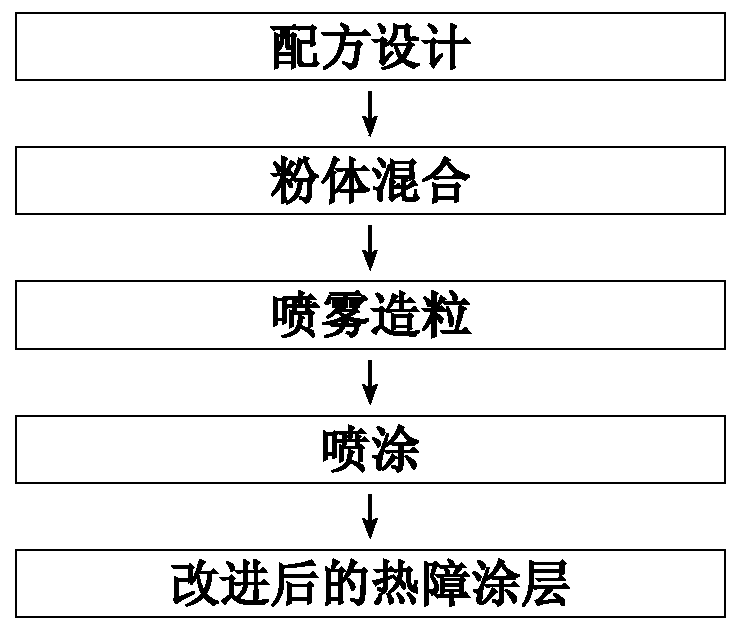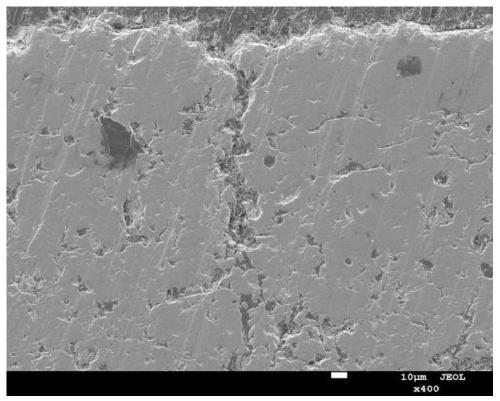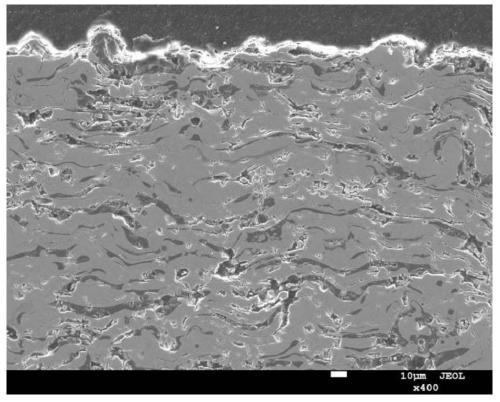A Polyoxide Co-doped Thermal Barrier Coating Resistant to Molten Glass Corrosion
A technology of thermal barrier coatings and polyoxides, which is applied in coatings, fusion spraying, metal material coating processes, etc., can solve the problems of coating failure and high cost
- Summary
- Abstract
- Description
- Claims
- Application Information
AI Technical Summary
Problems solved by technology
Method used
Image
Examples
Embodiment 1
[0045] according to figure 1 The flow chart shown prepares the ceramic layer of the polyoxide co-doped thermal barrier coating of the present invention:
[0046] According to mass percentage, Y 2 o 3 6.8%, ZrO 2 73%, Al 2 o 3 16.9%, TiO 2 3.3%; the specific steps are as follows:
[0047] Step 1. Powder mixing: Weigh the ingredients according to the formula designed in step 1, grind them thoroughly with an agate mortar, and mix evenly to obtain a uniformly mixed mixed powder 1;
[0048] Step 2. Spray granulation: use the mixed powder 1 uniformly mixed in step 1 to obtain the powder 2 for plasma spraying with a particle size between 20-40 μm by spray granulation;
[0049] Step 3. Spraying: The temperature at the center of the plasma arc is 2 x 10 4 In the case of K and He protection, the powder 2 prepared in step 2 is plasma sprayed at a spraying speed of 1 Mach, so that the powder 2 is deposited on the surface of the bonding layer NiCrAlY, and the layers are stacked...
Embodiment 2
[0052] according to figure 1 The flow chart shown prepares the ceramic layer of the polyoxide co-doped thermal barrier coating of the present invention:
[0053] According to mass percentage, Y 2 o 3 5.1%, ZrO 2 59.1%, Al 2 o 3 13.0%, TiO 2 3.25%; Nd 2 o 3 9.0%; Yb 2 o 3 10.55%; the specific steps are as follows:
[0054] Step 1. Powder mixing: Weigh the ingredients according to the formula designed in step 1, grind them thoroughly with an agate mortar, and mix evenly to obtain a uniformly mixed mixed powder 1;
[0055] Step 2. Spray granulation: use the mixed powder 1 uniformly mixed in step 1 to obtain the powder 2 for plasma spraying with a particle size between 20-40 μm by spray granulation;
[0056] Step 3. Spraying: The temperature at the center of the plasma arc is 2 x 10 4 In the case of K and He protection, the powder 2 prepared in step 2 is plasma sprayed at a spraying speed of 1 Mach, so that the powder 2 is deposited on the surface of the bonding l...
Embodiment 3
[0059] according to figure 1 The flow chart shown prepares the polyoxide co-doped thermal barrier coating of the present invention:
[0060] According to mass percentage, Y 2 o 3 6.0%, ZrO 2 65.0%, Al 2 o 3 13.0%, TiO 2 3.3%; Nd 2 o 3 5.0%; Yb 2 o 3 7.7%; the specific steps are as follows:
[0061] Step 1. Powder mixing: Weigh the ingredients according to the formula designed in step 1, grind them thoroughly with an agate mortar, and mix evenly to obtain a uniformly mixed mixed powder 1;
[0062] Step 2. Spray granulation: use the mixed powder 1 uniformly mixed in step 1 to obtain the powder 2 for plasma spraying with a particle size between 20-40 μm by spray granulation;
[0063] Step 3. Spraying: The temperature at the center of the plasma arc is 2 x 10 4 In the case of K and He protection, the powder 2 prepared in step 2 is plasma sprayed at a spraying speed of 1 Mach, so that the powder 2 is deposited on the surface of the bonding layer NiCrAlY, and the la...
PUM
| Property | Measurement | Unit |
|---|---|---|
| particle size | aaaaa | aaaaa |
| porosity | aaaaa | aaaaa |
Abstract
Description
Claims
Application Information
 Login to View More
Login to View More - R&D
- Intellectual Property
- Life Sciences
- Materials
- Tech Scout
- Unparalleled Data Quality
- Higher Quality Content
- 60% Fewer Hallucinations
Browse by: Latest US Patents, China's latest patents, Technical Efficacy Thesaurus, Application Domain, Technology Topic, Popular Technical Reports.
© 2025 PatSnap. All rights reserved.Legal|Privacy policy|Modern Slavery Act Transparency Statement|Sitemap|About US| Contact US: help@patsnap.com



